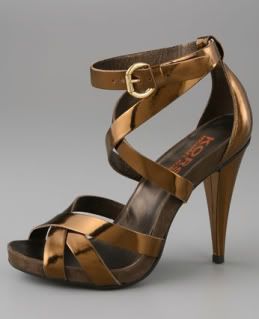
Michael Kors's Double X Band High Heel
Material- Leather
Spring, 2009
Heels are shoes whose heel is higher than the toe. According to high fashion shoe websites like Jimmy Choo and Gucci, a "low heel" is considered less than 2.5 inches, while heels between 2.5 and 3.5 inches are considered "mid heels," and anything over that is considered a "high heel."(Wikipedia)
HISTORY OF HEELS
The heels were originated around 1500, to solve the problem of rider’s foot slipping forward in stirrups while riding. And the rider’s heel are still remain today as cowboy boots.
In 1533, Catherine de’ Medici, the wife of the Duke of Orleans commissioned a shoemaker to craft a pair of heels, in order to increase her stature and for fashion. And they were an adoption of chopines, which are the most elaborate elevating shoes during the 15th and 17th.

Turkish Woman with Slave, wore chopines, late 18th century
Jean-Etienne Liotard
© Musée d'art et d'histoire, Ville de Genève
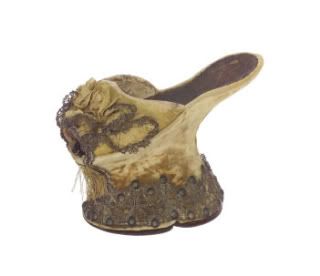
Chopine
Designer - unknown
Italian, 1580-1620
THE WELL-HEELS
By the late 1590’s, wealthy fashion-conscious men and women all over Europe quickly adopted the new style of shoe: the well-heels. They became an indicator of wealth and status and were committed only to upper-class.
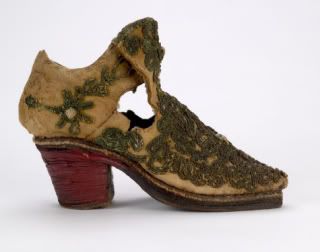
Boy's shoe
Designer - unknown
Possibly French, 1680-1700
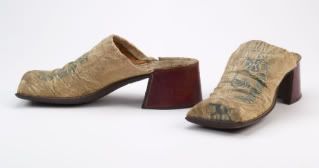
Man's mule
Designer - unknown
English, 1710-1730
THE LOUIS HEELS
By the 1730’s, men began abandoning the heels. Anyway, they still stayed in women’s fashion.
The women heel were “curved through the waist and splayed at the base to increase stability.” (Wikipedia).
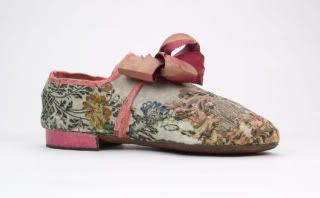
Man's brocaded silk shoe with ribbon closure
Designer - unknown
Possibly French, 1760-1780

Silk shoes with yellow silk covered heels
Designer - unknown
Possibly French, 1760s
LOW PROFILE
During the French Revolution, heels trend declined steeply in French due to its connection with wealth and aristocracy. Flat shoes were fashion for both sexes.
And the heels returned again by the late 1800s, especially for women, due to the creation of wide paved boulevards in cities such as Paris and New York.

Leather shoes with low heels
Designer - unknown
American, c. 1790s
THE WAR YEARS
During the darker years of the 1940s, shoemakers made the heels by materials that were not rationed, like wood straw.

Straw and wood platform
Designer - unknown
French, 1944-1945
THE STILETTO
When World War II ended, men returned to work, while women return to house and home. The stiletto heels stressed femininity by enrich women’s hourglass figure.
Together with the invention of the steel heel that was thin, able to sustain great pressure. The new stilettos truly ruled the fashion.

Christian Dior sketch, late 1940s
Rene Gruau, France
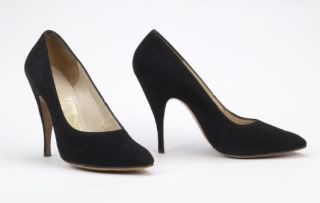
Black suede stilettos
Designed by Salvatore Ferragamo
Italian, 1955
UNISEX STYLE
The men of the 1970s once again wore heels. Male rock stars originated the trend by wearing decorated high platforms, and it then followed by their fans.

David Bowie, 1970s
Michael Ochs Archive
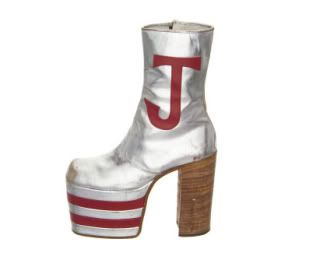
Silver and red platform boot, worn by Elton John
Designer - unknown
English, 1974-1976
ALL WALKS OF LIFE
During the late 20th century, with the influences of popular culture, high heels remained an outstanding element in both high and street fashion.
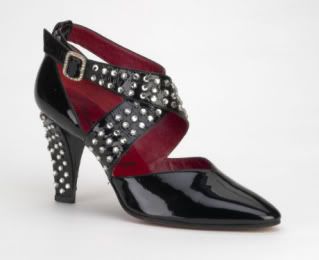
Patent leather shoe embellished with rhinestones
Designed by Yves Saint-Laurent
French, 1985-1988
HIGH FASHION
In today’s fashion world, there are tons of heels. High-end brands like Jimmy Choo and Blahnik have created them as luxury goods.
Through five hundred years ago, although the technology, trend,and style have changed, the heels' core has still remained as statue enhancement, an indicator of status and sex appeal.

Bronzed leather sandal with metal wedge heel
Designed by Tom Ford for Yves Saint Laurent
French, 2001

Fendi's Illusion high-heels
Material - Unknown
Fendi, Spring 2009
Source: http://en.wikipedia.org/wiki/High-heeled_footwear
http://www.heeldirectory.com/heel-shoe-history.html
http://www.batashoemuseum.ca/index.html

No comments:
Post a Comment